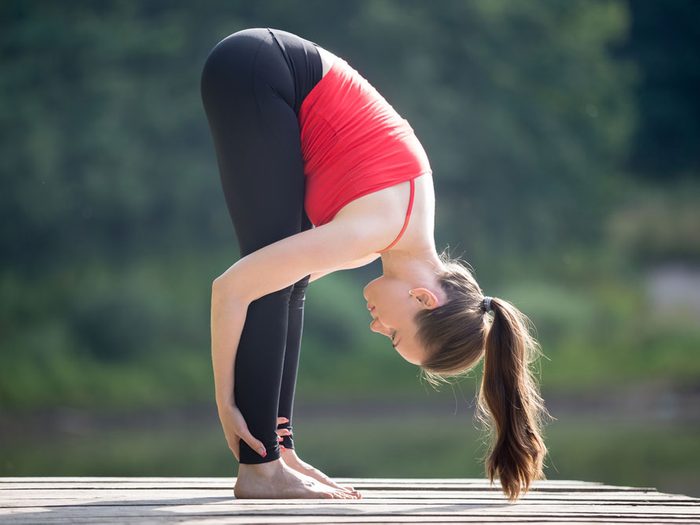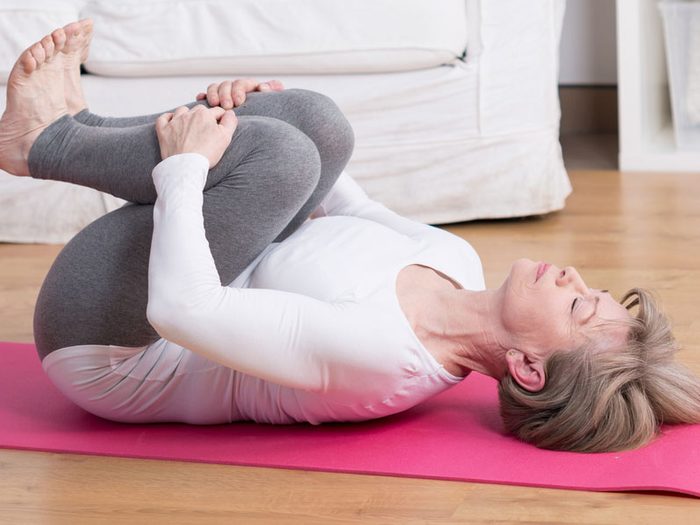
Yoga increases your flexibility
According to a 2011 study from International Yoga Journal, flexibility is “the first and most obvious benefit of yoga.” When you regularly practice yoga, you gradually loosen muscles and connective tissues surrounding bones and joints. But there are immediate effects, too. When you do the poses, you increase blood flow in your muscles, which improves function.
Yoga Tip: Take a class that doesn’t just focus on certain body parts but the entire body and poses that go through a full range of motion. Be very mindful with each pose, and don’t overstrain yourself, says Lisa Nelson, a family physician, director of medical education at the Kripalu Center for Yoga and Health and co-author of Yoga and Diabetes. Over straining or extending can lead to an injury.

Regular yoga can improve your joints
That blood flow and muscle loosening we just talked about… well, it also does wonders for your joints. “Studies show that the regular practice of yoga can reduce joint pain, improve range of motion and increase muscle strength, which can relieve stress on the joint itself,” says Nelson. “Yoga is a gentle, weight-bearing activity that can relieve symptoms of arthritis, as well as improve bone strength and resiliency.”
Yoga Tip: If you do have any joint pain or other issues, tell your instructor. Even though regularly practicing yoga can improve joints, it’s best to let your instructor modify moves that may put stress on any area you’ve injured.

Yoga gets rid of muscle soreness
Feeling some pain after a tough physical event, like running a 5 or 10K, or even a tough boot-camp workout? You’re likely experiencing delayed onset muscle soreness (DOMS), and a good yoga session will help. “The gentle and meditative side of yoga is a great counterbalance to strenuous training,” says nutritionist and yoga expert Annie B. Kay MS RDN RYT, also co-author of Yoga and Diabetes.
Yoga Tip: If you are experiencing DOMS and want some relief, try a yoga class that focuses on stretching and meditation such as a hatha or restorative class.

Yoga improves balance
“Yoga is an excellent practice for increasing balance,” says Nelson. “Clinical studies show it can reduce the risk of falls in the elderly and for people with Parkinson’s disease.” Nelson says moves like tree, eagle, half-moon and even mountain, strengthen the small muscles in the feet and legs. And they “provide important feedback for our nervous system to help us maintain balance and prevent falls.”
Yoga Tip: If you’re finding a pose to be particularly off balancing, ask your instructor for a modification.

Yoga keeps you young
An anti-aging solution that doesn’t come as a $100 pot of cream?! It’s true – yoga can help boost youthfulness. “We are now discovering one of the possible mechanisms behind the anti-aging benefit of yoga,” says Nelson “It has to do with telomeres, and their role in cellular aging.” She describes telomeres as strands of DNA that sit on the end of each of our chromosomes, like a little cap. “Each time our cells divide, and our DNA replicates, these end caps shorten a tiny bit. If they get too short, the cells can no longer function and shut down. Short telomeres are a sign of cellular aging, and are associated with many chronic diseases, including diabetes, heart disease and dementia.
To prevent this process of cellular aging, there is an enzyme our bodies produce called telomerase that helps our telomeres stay long and healthy. Yogic practices, like meditation, have been shown to increase telomerase activity, thereby reducing cellular aging.” She sites research by Dean Ornish MD as demonstrating an increase in telomere length.
Yoga Tip: Just like a “miracle face cream,” you have to use yoga regularly to see results.

Yoga improves your sex life
Yoga improves muscle function and blood flow, so why wouldn’t it help other physical activities, including sex? According to the Harvard Health Letter, there is some research on sexual function and yoga. At the end of a 12-week study of 22 women aged 22 to 55, their scores for desire, arousal, lubrication, orgasm, pain, and overall satisfaction with sex improved after doing moves like trikonasana (triangle pose), bhujangasana (the snake), and ardha matsyendra mudra (half spinal twist). And women aged 45 and older showed the greatest improvements with arousal, lubrication and pain.
Yoga Tip: Sex should be fun, so don’t stress in your yoga class (or in bed) over it. And if you’re having major issues, talk to your doctor.

Yoga reduces stress
Stress has a very physical effect in the body. “Stress activates our sympathetic nervous system, putting us into a fight or flight response,” says Nelson. “Many people these days are so stressed that they are chronically in fight or flight mode, which can lead to metabolic dysfunction, anxiety, depression and other chronic health problems.” So how does yoga help? Nelson says that it activates the parasympathetic nervous system, also known as the rest and relax response. “The more we do yogic practices like asanas postures, meditation and slow breathing, the more relaxed we can become.”
Yoga Tip: If you’re in a yoga class and you’re not feeling relaxed, really focus on your breath and the mind-muscle connection. Slow down your breathing and make sure your breaths are deep.

Yoga helps control blood sugar
There are two ways yoga help regulates blood sugar, says Nelson. The first one is that yoga is exercise. “When we move through postures at a moderate or vigorous pace, yoga helps to lower blood sugar and improve the way our body utilizes insulin, decreases insulin resistance,” says Nelson. “This is similar to other forms of exercise.” The other way yoga helps regulate blood sugar is by reducing stress levels, she adds. “Stress can be especially damaging to people with diabetes because stress hormones, like cortisol, can raise blood sugar. Stress also tends to make it hard for us to take care of ourselves in positive ways,” causing us to overeat, make poor food choices, and makes us less mindful of our body and our health.
Kay adds to that: “As a dietitian and yoga teacher for many years, I can see that people with a regular yoga practice just eat better. I spend a lot less time convincing them to eat vegetables or cut down on sugars.”
Yoga Tip: Carry healthy snacks in your bag for post-yoga. And if you do have to skip a class for an important reason, be mindful of the health benefits you’re missing and make better choices when it comes to food.
